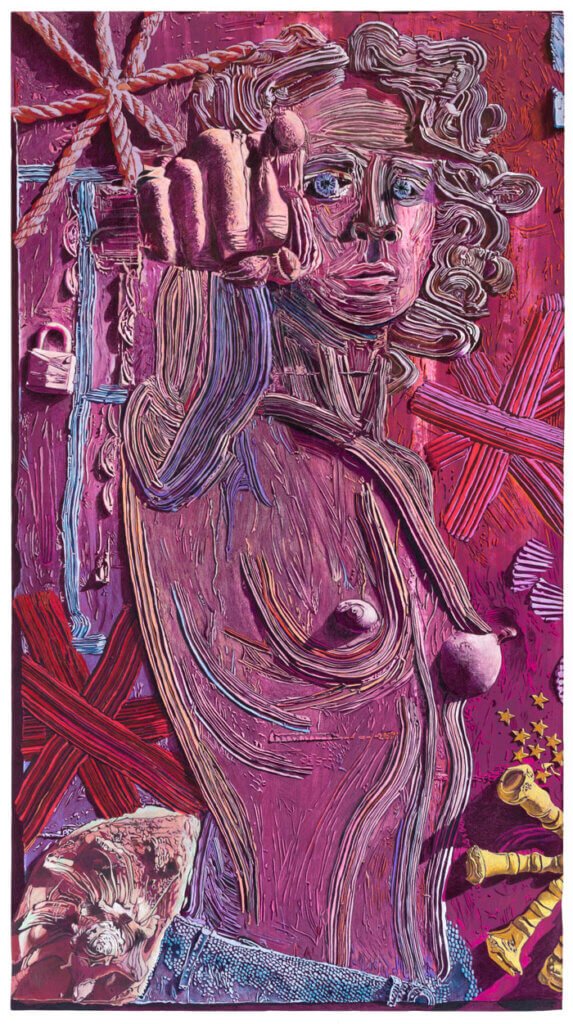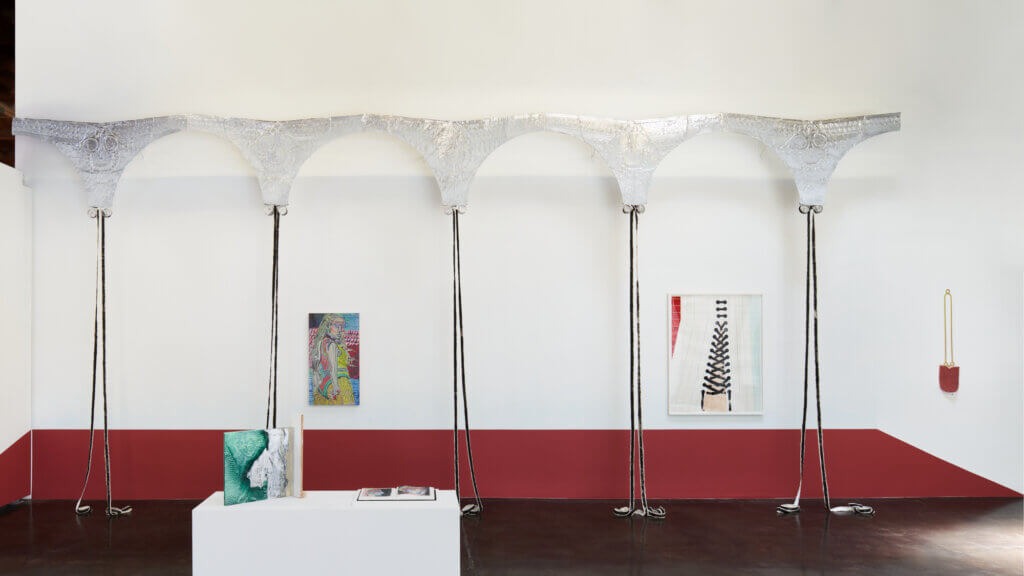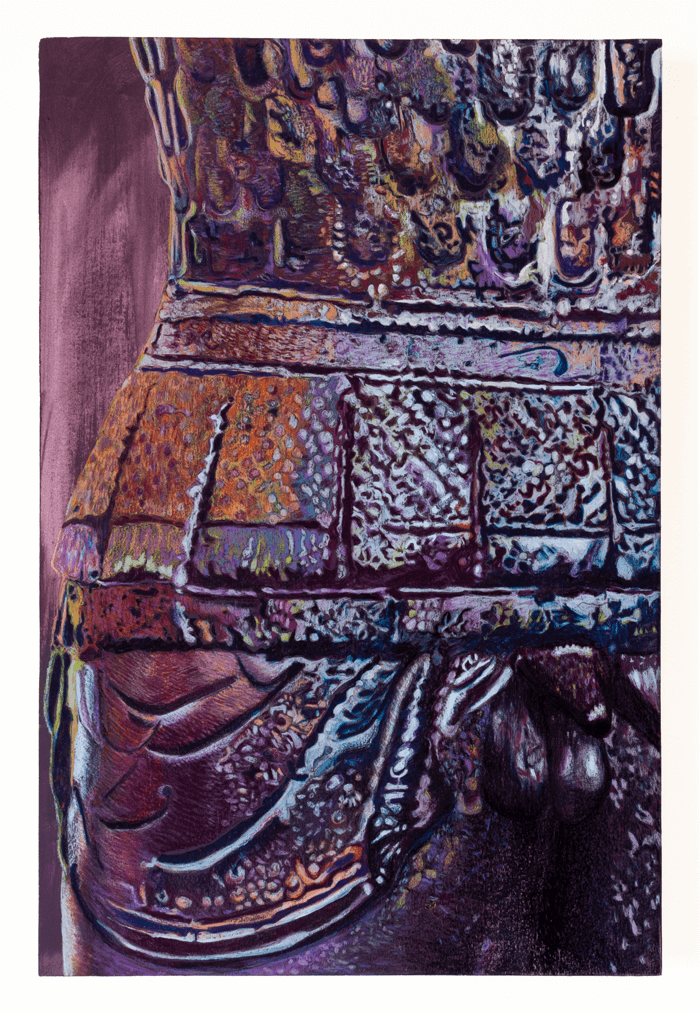California-based artist Amy Nathan‘s work, ranges from sculpture and painting to installation. Informed by notions such as the gendered spirit of politics and power, classical mythology and literature, and the body’s visceral response to its habitat. Nathan’s practice asks questions about how meaning can be expressed through visual languages.
In Nathan’s latest body of work, part of her exhibition “Slipknot Loophole” at CULT Aimee Friberg Exhibitions, Nathan takes viewers on a material investigation guided by a critical analysis of the distance between image and embodiment. Articulated in a harmonious convergence of materials, architecture, and figurative imagery accentuated by Nathan’s utilisation of bas relief, the exhibition confronts the mechanisms women use to hold themselves together, delivering distinctive consequences the senses cannot ignore.
I address many subjects in my work: the gendered nature of politics and power, classical mythology and contemporary literature, and the body’s visceral reaction to its environment
Amy Nathan
Nathan’s work has been exhibited at Center for the Arts, AORA London, Traywick Contemporary, Facebook and the International Sculpture Center; she has also been featured in Artforum, Art Maze Magazine, New American Paintings, Sculpture Magazine and Juxtapoz. We caught up with Amy to learn more about her practice, inspiration and more.
Q: Hi Amy, can you please introduce yourself for those who do not know you?
A: I grew up in the Midwest and moved to California after finishing my undergrad degree at the University of Michigan. I was a graphic designer for many years—painting when I could—then I shifted and intensified my art practice a few years ago. I went back to school and got an MFA at Mills College in Oakland, and now I work in a studio in West Oakland. I live close by in Berkeley, California.
My sculptures, installations and drawings apply pressure to objects and language, cracking open their systems and expanding them into space. Putting ideas through the wringer, taking-apart-and-putting-back-together is my research and my practice. Through these processes, I discover how chosen objects or words operate and communicate what is embedded within.
I address many subjects in my work: the gendered nature of politics and power, classical mythology and contemporary literature, and the body’s visceral reaction to its environment. Drawing from my early career as a typographer, I deploy a set of symbols or “tools” to dismantle and reconfigure the female narrative. I relate the small mechanisms women use to hold their bodies and lives together to the words, will and strength required to do so. Repeated and regular use changes these tools—bobby pins, rope, zippers, safety pins, locks—into the alphabet women use to present themselves in the face of contemporary culture.
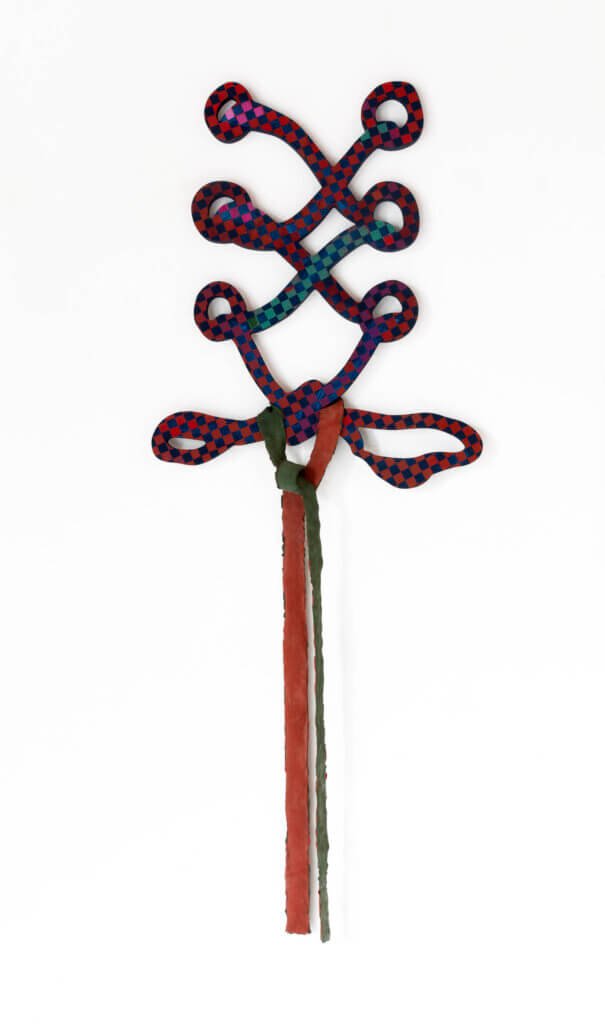
Acrylic and fl ashe vinyl paint on wood, pigmented cast latex 46 x 17.5 x 2 inches
Courtesy of the artist and CULT Aimee Friberg Exhibitions
Q: Can you tell us how you got started in arts and why you decided to become an artist?
A: I always drew and painted as a child and then studied graphic design in college to ensure I could get a job. Design was engrossing for me for many years, but when I had children, I started to work part-time, and the freelance jobs I could get with those limited hours tended to bore me. I began to spend more time painting in my basement, and then it bloomed in my brain, and I felt all this momentum to keep going to figure out how to make sculptures.
Q: Your practice applies a critical investigation of the distance between image and embodiment represented through diverse materials. Can you tell us more about your practice, what inspires your work and the creative process and the direction your work is going?
A: Although I haven’t used text in my work, language—both in meaning and in its formal qualities—is often a starting point. I incorporate visual puns and material onomatopoeias: line becomes edge becomes surface, traversing a borderline of two and three dimensions as a way to think through perception. As I translate forms from one state to another, a rhythm emerges from this studio play.
A sequence of moves could include, for instance: make a drawing; carve that form in clay using a bricolage of tools; cast the form in plaster; emboss the hardened surface into metal sheeting; wrap the metal face around an armature and paint to shift the surface quality. The original drawing tools I use change functionality and become a new hybrid: still recognizable, but also read as drawn marks constructing a narrative. It’s an alteration in the thing’s etymology, suggesting the movement, transition and fluidity present in body and identity.
In my current show, I wanted to create an experience of visual rhymes in the imagery. Faces, objects and linework appear and reappear, circulating through the exhibition. In several sculptures, an image is cast onto itself multiple times, and in different materials, some are opaque layers, and some are transparent. Drawings are reimagined as sculptures so that what was a draping, loose ink line becomes a wooden armature that stands on its own. There is a search for the vestige’s origin that I’m interested in—that archaeological line we follow, hoping to find answers to write the history, to make the myth.
Q: Your current exhibition, “Slipknot Loophole”, examines the agencies women use to hold themselves together to express liberation is a vital part of those systems. Can you tell us about the essence of the exhibition and the significance of your works on display?
A: Extending from the core—source of strength and stability in the body—Slipknot Loophole considers the feminine torso in art history and contemporary culture. Two visual stories are running through the show. One starts with the ribbons, grommets and bows that flex and release a corset. They become sequential dots and lines in a series of drawings and painted wood sculptures.
The corset pieces continue my “objects as handwriting” project—using ink and brush, I draw objects within a gridded structure, evoking lined looseleaf or graph paper. In the “Corset Grid” drawing series, the laces pull and release this framework. In painted wood sculptures such as “Flying Buttress” and “Shine Your Heavenly Body Tonight,” the looping and drooping shapes are removed from a grid and find agency; they strike their own power pose.
The other vein is a mash-up of classical and contemporary figuration of goddesses and performers. This manifests as cast bas relief sculptures and paintings of those sculptures. They are titled after the pop psychology idea of the “power pose,” which is meant to trick your brain into believing what your body tells it to feel: stand powerfully and become powerful. The performers pictured in my Power Pose series exude charisma and presence. I reshuffle archetypes like Athena, Andromeda, Medusa, J. Lo and Britney Spears into each other’s contexts. Paparazzi photos and celebrity selfies are remade as Etruscan-style bas reliefs and pause as paintings, combining figurative imagery with geometric pattern and decoration.
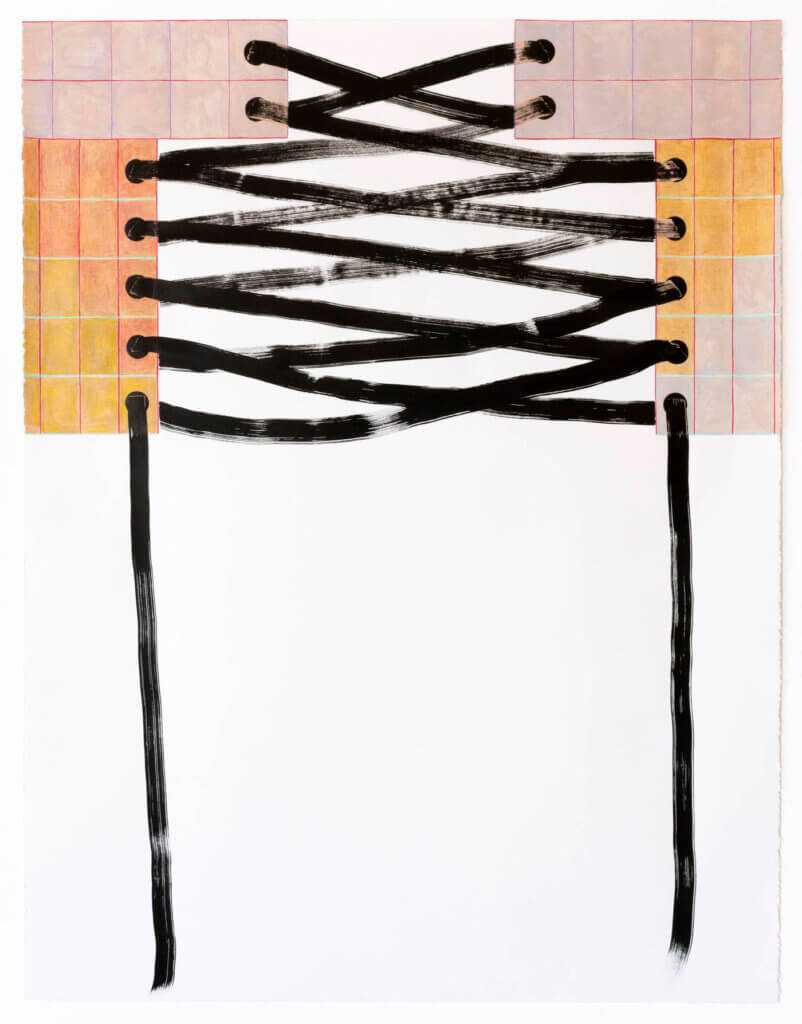
Corset Grid II (Exhale), 2021
Ink, flashe vinyl paint, and colored pencil on paper 50 x 38 inches
Courtesy of the artist and CULT Aimee Friberg Exhibitions
Visually, the corset drawings and sculptures are much looser than these tightly rendered paintings. To bridge that distance, I encrusted the wood sculptures with pattern and also relate the two directions through colour palette and surface quality. To me, they are especially connected in the way they reference language. In the bas relief sculptures and the paintings, small everyday objects are repeated in sequence and knitted together into a new lexicon.
The loose corset drawings reference small mechanisms writ large, using a calligraphic mark that reads close to handwriting. I convert these into sculptures the size of bodies and architecture—my work contracts and expands in space, from close reading to bodily experience.
Q: Pelvic Portico is a large installation built from a hybrid of lace underwear and the armoured exoskeletons of war. Can you tell us the inspiration behind this piece, how long it took to complete, and its meaning?
A: Pelvic Portico is made from embossed and painted aluminium sheets hung on metal supports extending from the wall. Each unit that makes up the structure forms the image of a pair of lacy underwear, and they cap an “Ionic column” that is made from a canvas bow, each loop filled with an aluminium spiral, each length pooling on the floor below. A portico is a structure of columns supporting a roof attached to a building—so a space that is not exactly inside or outside. Like lingerie, a portico is an interface or a skin between public and private.
Once I landed on the thought that a pair of women’s underwear could be repeated in sequence to form archways, I kept drawing the idea and writing about how I could make them. I made versions in large-scale drawings on paper and then on cloth, in cast plaster tiles, cast pigmented silicone with organza backings, cast and painted paper maché.
Also, the way the aluminium combines delicacy with the ability to hold the whole image across the arch’s span; its reference to shields and armour (in antiquity, armour was often made in the shape of the body beneath: a breastplate was a sculpted torso, leg protective covers had moulded calves, foot armour had toenails inscribed into the metal). The aluminium could also hold the little tears and bends and tender draping quality like silk or thin cotton.
The pattern embossed into the form is loosely based on a mash-up of a classical mural’s flowering vine and an Etruscan perforated shield disk. The flower is partly made from a swooping rope bow, which in its placement reads like fallopian tubes. The combination of columns and rigidity of traditional Western architecture, with the softness and vulnerability of bodies, feel like something about this moment of betrayal, control and restriction that the Supreme Court is about to hand down to the people, but especially the women, of the United States.
Q: They say the studio is the sacred template of creativity. What are the three things you cannot live without in your studio?
A: 1. Books! I keep some favourite poetry, and essay volumes close at hand and reference them often. Anne Truitt’s journals, Rachel Cusk’s Coventry, Amy Sillman’s Faux Pas, Mary Ruefle’s Madness, Rack, and Honey, Ovid’s Metamorphoses, Sharon Olds’s Odes are a few.
2. Sumi ink: even when working as a graphic designer and typographer, and especially now, I have always started projects with loose ink drawings.
3. Sunlight: I’m so lucky to have a studio with windows, and the bright morning light is my everyday happiness.
Q: What’s next for you as an artist?
A: I’m looking forward to picking up some threads I’ve left dangling in the studio. One of my professors at Mills gave me the best advice: to always leave something for yourself in the studio as you finalise an exhibition. At this moment, I have started a series of paintings and sculptures that follow a train of thought about mermaids or sirens and what they might have to say about climate emergency.
They are looking worried, and I’m not sure exactly where they will go. I am also starting a big drawing book; I’m thinking about literally writing a book using my object handwriting as the text. I am excited about the arrival of a new clay slab roller, which will allow me to make bigger base relief sculptures, and I’m interested in making some wall-size friezes. I’m also hoping to try glass and bronze casting in the coming year.
Q: Lastly, what does art mean to you?
A: Art is a way of experiencing the world—the curiosity or force that brings me to make something allows for expansiveness in thinking and being. I’ve almost always filtered my life through an art lens, and the times I’ve let it lie fallow have felt hollowed out. It’s a record of life, too; art contains memory. Art is an offering, a record, an opening, a question.
https://www.instagram.com/amy_nathan_/
©2022 Amy Nathan




